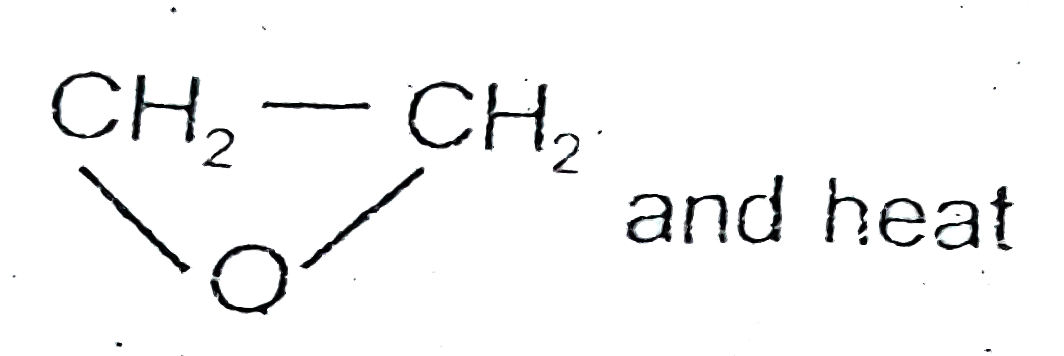In the reactions
CH2∣∣CH2Hypochlorous−−−−−−−→acidMR−−→CH2OH∣∣
∣∣CH2OH
M and R are respectively
CH3CH2Cl and NaOH
CH2Cl−CH2OH and aq NaHCO3
CH3CH2OH and HCl

The correct Answer is:B
To solve the question, we need to identify the compounds M and R in the given reactions involving ethene and hypochlorous acid.
1. Identify the Starting Material:
- The starting material is ethene, which has the molecular formula C2H4 or CH2=CH2.
2. Reaction with Hypochlorous Acid:
- Ethene reacts with hypochlorous acid (HOCl). This is an addition reaction where the hypochlorous acid adds across the double bond of ethene.
- The addition of HOCl to ethene results in the formation of ethylene chlorohydrin. The reaction can be represented as:
CH2=CH2+HOCl→CH2(OH)CH2Cl
- Therefore, the product M is ethylene chlorohydrin, which can be written as CH2(OH)CH2Cl.
3. Identify Product M:
- M is thus identified as ethylene chlorohydrin, with the structure CH2(OH)CH2Cl.
4. Reaction of M with R:
- The next step involves the reaction of M (ethylene chlorohydrin) with aqueous sodium bicarbonate (NaHCO3). This reaction typically leads to the conversion of the chlorohydrin to ethylene glycol.
- The reaction can be represented as:
CH2(OH)CH2Cl+NaHCO3→CH2(OH)CH2(OH)+NaCl+CO2+H2O
- The product formed is ethylene glycol, which has the structure CH2(OH)CH2(OH).
5. Identify Product R:
- R is identified as aqueous sodium bicarbonate (NaHCO3).
Final Answer:
- M is ethylene chlorohydrin (CH2(OH)CH2Cl).
- R is aqueous sodium bicarbonate (NaHCO3).
- The starting material is ethene, which has the molecular formula C2H4 or CH2=CH2.
- Ethene reacts with hypochlorous acid (HOCl). This is an addition reaction where the hypochlorous acid adds across the double bond of ethene.
- The addition of HOCl to ethene results in the formation of ethylene chlorohydrin. The reaction can be represented as:
CH2=CH2+HOCl→CH2(OH)CH2Cl
- Therefore, the product M is ethylene chlorohydrin, which can be written as CH2(OH)CH2Cl.
- M is thus identified as ethylene chlorohydrin, with the structure CH2(OH)CH2Cl.
- The next step involves the reaction of M (ethylene chlorohydrin) with aqueous sodium bicarbonate (NaHCO3). This reaction typically leads to the conversion of the chlorohydrin to ethylene glycol.
- The reaction can be represented as:
CH2(OH)CH2Cl+NaHCO3→CH2(OH)CH2(OH)+NaCl+CO2+H2O
- The product formed is ethylene glycol, which has the structure CH2(OH)CH2(OH).
- R is identified as aqueous sodium bicarbonate (NaHCO3).
- M is ethylene chlorohydrin (CH2(OH)CH2Cl).
- R is aqueous sodium bicarbonate (NaHCO3).
Topper's Solved these Questions
- HYDROCARBONSBOOK - AAKASH INSTITUTE ENGLISHCHAPTER - HYDROCARBONSEXERCISE - SECTION-C OBJECTIVE TYPE QUESTIONS (MORE THAN ONE OPTIONS ARE CORRECT)
12 Videos
- HYDROCARBONSBOOK - AAKASH INSTITUTE ENGLISHCHAPTER - HYDROCARBONSEXERCISE - SECTION-D LINKED COMPREHENSION TYPE QUESTIONS
7 Videos
- HYDROCARBONSBOOK - AAKASH INSTITUTE ENGLISHCHAPTER - HYDROCARBONSEXERCISE - ASSIGNMENT SECTION-A COMPETITION LEVEL DIFFER BY
50 Videos
- HALOALKANES AND HALOARENES BOOK - AAKASH INSTITUTE ENGLISHCHAPTER - HALOALKANES AND HALOARENES EXERCISE - ASSIGNMENT SECTION -D
15 Videos
- HYDROGENBOOK - AAKASH INSTITUTE ENGLISHCHAPTER - HYDROGENEXERCISE - ASSIGNMENT (SECTION - D) (Assertion-Reason Type question)
15 Videos
Similar Questions
Knowledge Check
In the given reaction:
CH3−OH∣CH−OH∣C∣OH−CH3HiO4−−→(A)+(B)
(A) and (B) respectively be:ACH3CHO and CH3CHOBCH3COCH3 and CH3CHOCCH3COCH3 and CH3COCH3DCH3COOH and CH3COOCH3
The IUPAC name of CH3−C∣CONH2=CH−CH2−O∣∣C∣OH is
View SolutionThe give reaction
H−CH2−CH3∣C∣CH3−Br ΘOH−−−−−→HO−CH2−CH3∣C∣CH3−H
Is an example of
View Solutionname the following reactions(i). R−CH∣OH−CH2COOHNaHCO3−−−−−→ΔR−CH∣OH−CH2−H
(ii). R−CH∣NO3−CH2COOHNaHCO3−−−−−→ΔR−CH∣NO3−CH2−H
(iii) R−C∣∣O−CH2COOHΔ−−→R−C∣∣O−CH3
View SolutionThe product of the given reaction ,
CH3−∣CH3∣C∣OH−CH3∣C∣NH2−CH3HNO2−−−→ Product is :
View SolutionC∣OHH(2)−C∣∣O−C∣OHH−C∣OHH2HlO4−−→ products
Products are:
View SolutionWrite the IUPAC names of the compounds i-iv from their given structures.
(i) 1CH3−2CH2−3CH∣OH−4CH2−5CH2−6CH∣CH3−7CH2−8CH3
View SolutionThe correct systematic IUPAC name of the given compound is :
CH2∣COOH−OH∣C∣COOH−CH2−C∣∣O−OH
View Solution
